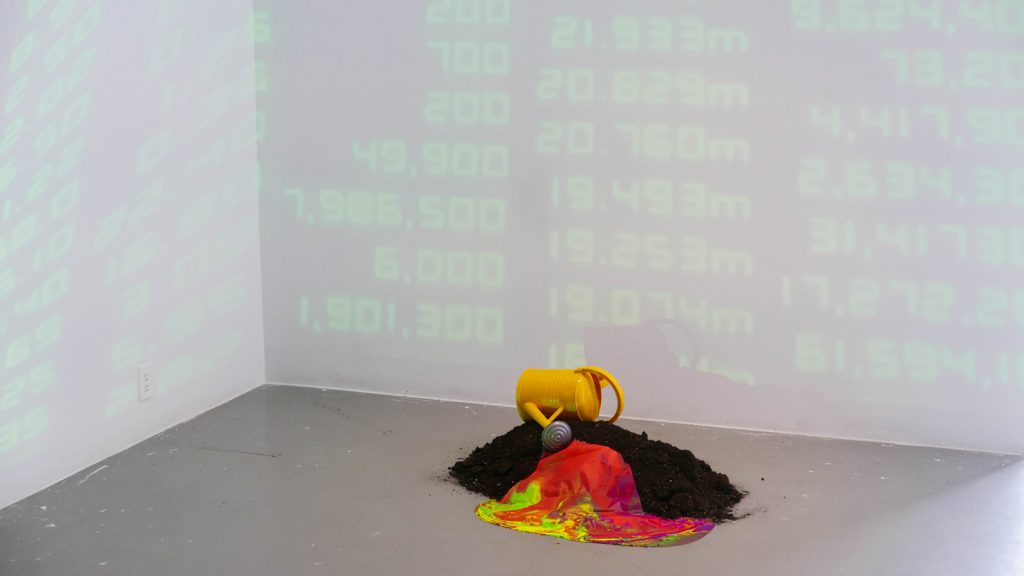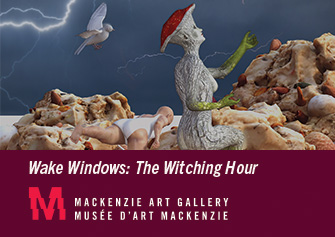Between Ice and Earth
19 September 2020
By Chris Gismondi
The exhibition, Between Ice and Earth which took place last summer at Xpace Cultural Centre, celebrated a close-knit community of Indigenous OCAD students, transcended barriers, and vibrated with a palpable uneasiness. The showing by Ana Morningstar, Dehmin Osawamick Cleland, Megan Feheley, Laura St. Amant, Amanda Amour-Lynx, Ben Kicknosway, Kaya Joan, and Tom McLeod addressed frustrations about the expectations of Indigenous art and the pressure of being makers inheriting Indigenous and settler cultural legacies. The artists responded to the familiar theme of relating to the land and space of Tkaronto, but with a distinct anxiety about anthropogenic pollution, the climate apocalypse, and how the continually degrading health of the land affects Indigenous protocols, ceremonies, and material practices. This angst presupposed our current political climate, while offering an antidote of community solidarity—a fundamental element which should not be ignored.
The sprawling concrete landmass of the urban metropole is usually imagined as a place of tension for Indigenous ways of being, harvesting, and land stewardship. The watershed of Chi’Niibish (“Big Water” in Anishinaabemowin referring to Lake Ontario) has been “reclaimed” or “developed” for new neighbourhoods, the lakefront currently spawns luxury condos and industrial buildings instead of wild rice, birch, cedar, and salmon. Kaya Joan’s iehiá:tons (2019) used street art to conceptually intervene into the landscape of Tkaronto by using graffiti tactics as an act of reclaiming. The video work depicts Joan tagging various urban locations in an attempt to restore Indigenous presences to these sites. These same tags are also displayed in the gallery on a large wood panel, which resembles a circular dish from the Dish with One Spoon wampum belt covenant between the Anishinaabeg and Kanien’kehá:ka. Both the film and the graffiti panel emphasize an Indigenous presence in the city and offer an urban Indigenous futurity. These alternative understandings of an urban environment draws parallels to the subterranean histories of Tkaronto, such as the buried tributaries and waterways of Holly Brook or Newcastle Creek beneath the city’s streets.
Land that is tainted not just through industry, but also through broken treaties and promises was the center of two other works in the exhibition. Alongside a body of works concerned about ecological degradation, artists Laura St. Amant and Ana Morningstar highlighted the land-theft process undertaken by the government and corporate developers that Indigenous communities resist on an ongoing basis. St. Amant reflected on family memories of fishing as a consistent bonding experience, here using bait as a warped metaphor for deceit. In Untitled Fishing Lure Pile (2019), the neon painting explores the beautiful colourful forms of unbaited hooks with the trickery and danger they guarantee. The composition is almost entirely synthetic pink with purple and blue highlights detailing the lures. A couple tendrils are accented in iridescent yellow. The vivid eerie colours of lures like these attract fish with a false promise of food, just as Indigenous peoples are routinely left waiting for governments to honour their commitments.
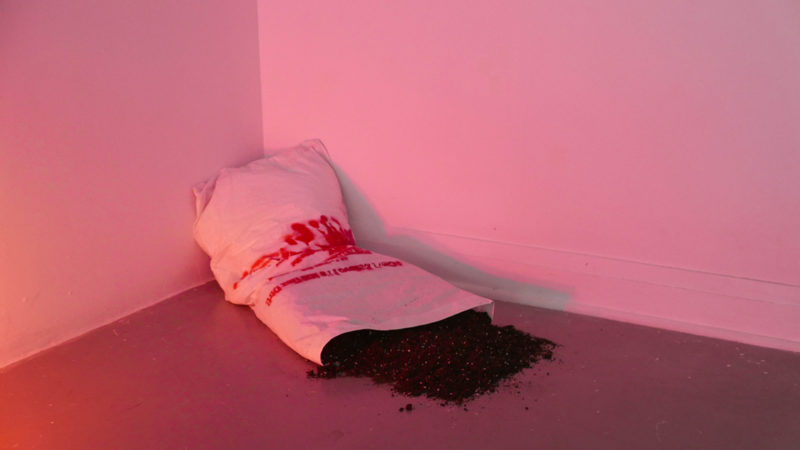
This deception is also reflected in Ana Morningstar’s tongue-in-cheek piece, I am buying my land back one bag at a time & getting a receipt this time (2019). The sculptural form was a literal bag of soil slumped against a corner with earth spilling out. On one hand there is optimism: what is the potential from this bag of earth? What will grow out of the most painful circumstances? But on the other, processes of land dispossession continue to play out as industrial-capitalist greed attempts to steal ever more land to be pillaged, poisoned, and extracted for resources. The solution of buying back occupied territory like bags of potting soil posed here via what she calls an “Indigenous humour” is absurd. (1) It would be a farce to attempt to use late-capitalist consumerism as a means for decolonization. Morningstar’s artistic commentary reveals the outrageous fallacy of commodifying nature, a historical process that still unfolds across settler-colonial sites. “Next we’ll be competing with Nestle by bottling our own rain dance water,” she wrote in accompanying wall text. While movements for land sovereignty continue against corporate interests, Morningstar also invites us to consider Indigenous futures.
The concept of Indigenous resiliency (2) is also shared outside of the human experience with animal and plant nations. Benjamin Kicknosway illustrates native animal species to explore displacement and the effects of habitat loss. His drawings, Blue Heron, Bruin Bear and Woodland Buffalo (2019) are all depicted in a solemn monochrome woodland style, which is a graphic tradition popularized by Anishinaabeg artists like Norval Moriesseau and Daphne Odjig. Each of Kicknosway’s animals sit isolated within a destroyed or dwindling habitat: the buffalo stands alone in a sparse plain, the bear stands in a dying forest, and the small flock of heron navigate inky pools with ashy clouds overhead. The accompanying text explains that three hundred years ago these animals coexisted on Turtle Island, but if they returned to their original homes today they would not survive. Often, Indigenous communities are on the frontlines of protecting biodiversity as industries continue to push for more land to be sacrificed for so-called development.
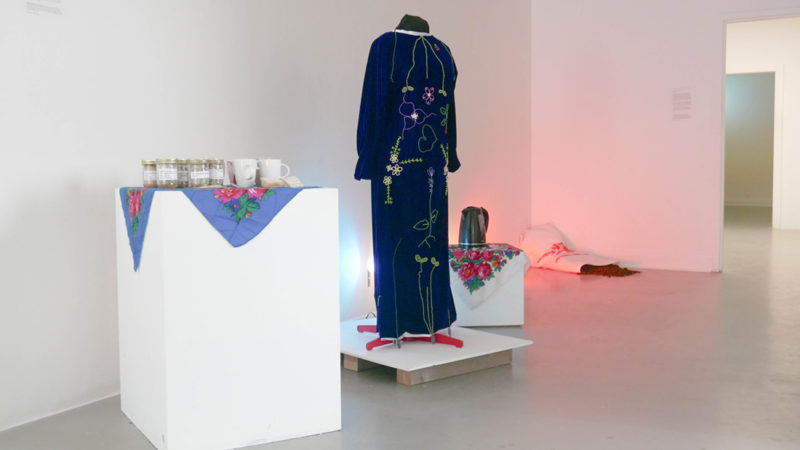
Dehmin Osawamick Cleland’s Dress That Teaches (2019) provides evidence of this protection, contrary to the dismay of colonialism’s ecological manifestations on the land and biodiversity. The royal blue dress is beaded with indigenous flora like strawberry, trillium, and cedar, which are found around the artist’s home in Wikwemikong, a reserve on Manitoulin Island. Alongside the beaded dress she offered a kettle, mugs, and jars of various harvested herbs. Cleland invited gallery goers to brew teas from medicinal plants like winter green, yarrow, wild ginger, sweetgrass, willow, and wood betony. She explained to me that each jar was labeled with the Anishinaabemowin word and the medicinal properties of how the plant affects the body. The reverence of these plant helpers in beadwork and sharing demonstrates that the land still provides and teaches when it is respected.
Curators Tom Mcleod and Megan Feheley included their own work amongst their peers. One of Mcleod’s animated video works, Greed (2018), addressed the oral history of the corrupting influence of taking more than what you need, a tenet in Inuit teachings. The work illustrated an oral history of hunting and refusing to share which is dangerous for the survival of a circumpolar community. Mcleod demonstrated varied animation styles, from the horrific and startling style of Greed to the beautifully soft graphite of Whale of a Tale (2018), whose sentimental style perfectly captured community stories around food security. The video depicts the beluga hunt for the Inuvialuit and traditional harvesting practices contrary to the historic incentives to abandon nomadic life and populate sedentary communities. While hunting practices may have changed due to climate and hunters are no longer “singing” the beluga into the delta, Mcleod demonstrates that community harvests like this still continue. The meat is divided and distributed throughout the community as it has always been done, the same way the hunting song had been shared across generations and the story of the hunt is shared today in new media like animation.
Megan Feheley explored a cultural continuity and adaptation of sorts as well with their piece Birch Bark Tarp (2019), which imagined the ancient practice of birch bark biting transposed onto a plastic tarp. Bark biting is a drawing process where a sheet of birch is folded and held in the mouth while the maker uses their teeth to apply pressure, breaking through the layers of bark. The sheet is maneuvered and rotated so that the intended design takes form, as the maker has to constantly visualize their intention and connect their mind, mouth, and hands. Feheley carries this practice onto a synthetic polyethylene tarp as the white birch species continues to decline. This cultural continuity carries contradictions like the permanency of plastic compared to the natural lifespan of Cree material objects and the regeneration of harvesting, making, and sharing. The resulting geometric design of two bitten rings bordered by four sets of parallel lines is further activated by a fan, which gives the petroleum plastic sheet a life force of its own. The tarp often resonates as a symbol of doomsday preparations, homeless shelters, or migrant camps, all of which are invoked as the climate crisis itself challenges all life on Earth. Feheley, admitted hesitation about translating the practice of biting onto plastic media as a “futile” attempt at cultural preservation and protection for teaching future generations. (3) Yet there are positive outcomes to something permanent (and made of oil) like synthetic sheeting which can never be taken away, never be fully destroyed. Even if no elders exist to pass on the knowledge, the apocalyptic tarp will remain like it’s polluting petro-chemical kin.Osawamick
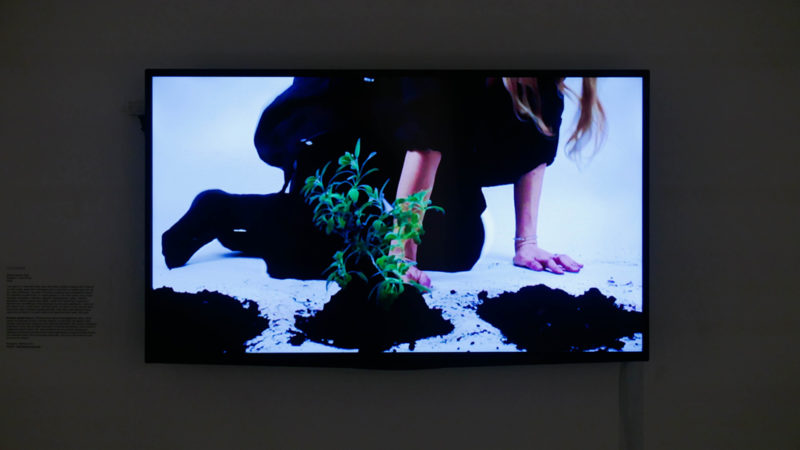
Both Feheley and fellow artist Amanda Amour-Lynx have large practices centered on institutional critique aimed at OCAD and the administration’s failings with accommodating trauma survivors. In Between Ice and Earth, however, Amour-Lynx departed from this body of work processing her own experiences to explore displacement and systems of resource extraction. Her video work Uprooted (2018) shows the artist gently replanting a sage seedling between three mounds of soil in a sterile room. The plant was grown from seed from her mother and connects to her own family history and experience of displacement from Mi’kma’ki, Montréal, and now Tkaronto. With each transplanting the seedling is shocked. Amour-Lynx explores if home or belonging is a feeling that can ever be found when you are forced to move. Meanwhile, her multi-media sculptural, video, and audio work Trading Post (2017) highlights resource extraction cycles in history. The work projects 2008 stock market numbers over a sculpture of neon-garish “tailing slime” sliding down a pile of earth. The audio overlay recites portage routes, trade agreements, Hudson’s Bay Company fur trading narratives, and media coverage of nuclear, oil, and tailings spill disasters along with stock market analysis and ambient sounds. Amour-Lynx boldly connects extractivism to the re-occurring commoditization of nature. Within this circus, news media and the consumption of information plays a crucial role into which crises we deem worthy of attention and outrage and which go unnoticed. Why do we hear more about stock market collapses than ecological ones? Amour-Lynx demonstrates a long history of exploitation based on stolen lands, unstable capitalism, and a complete lack of accountability.
Together, the artists featured in Between Ice and Earth attack issues of land sovereignty, exploitation, and the degrading natural world with conceptual complexity and adventurous mediums. They are clearly working beyond defining themselves as “Indigenous” makers and critiquing the simplified Indigenous art discourse, the traditional versus contemporary dichotomy, the urban-rural community divide, as well as the institutional practices that contain them. As much as this show was about critiquing the institution and contemporary culture at large, it was simultaneously a celebration of community and continued resistance to pollutants such as institutional racism, colonial consumption, and accumulating greenhouse gases. In this sense, Between Ice and Earth offers an example of how to forge genuine human relationships while protecting life forces of the air, water, and land. This humble yet grand conclusion is an extremely appropriate lesson for us today, almost a year later in a world more full of uncertainty and impending changes.
1. Anna Morningstar, didactic panel, I am buying my land back one bag at a time & getting a receipt this time (2019), Xpace Cultural Centre.
2. Marjo Lindroth and Heidi Sinevaara-Niskanen, “Colonialism Invigorated? The Manufacture of Resilient Indigeneity”, in Resilience, volume 7, issue 3 (2019), 240-254.
3. Megan Feheley, didactic panel, Birch Bark Tarp (2019), Xpace Cultural Centre.
Feature Image: Installation view of Trading Post, 2017 by Amanda Amour-Lynx. Photo courtesy of Xpace Cultural Centre.
Between Ice and Earth ran from June 26-30 2019 at Xpace Cultural Centre in Toronto, ON.

